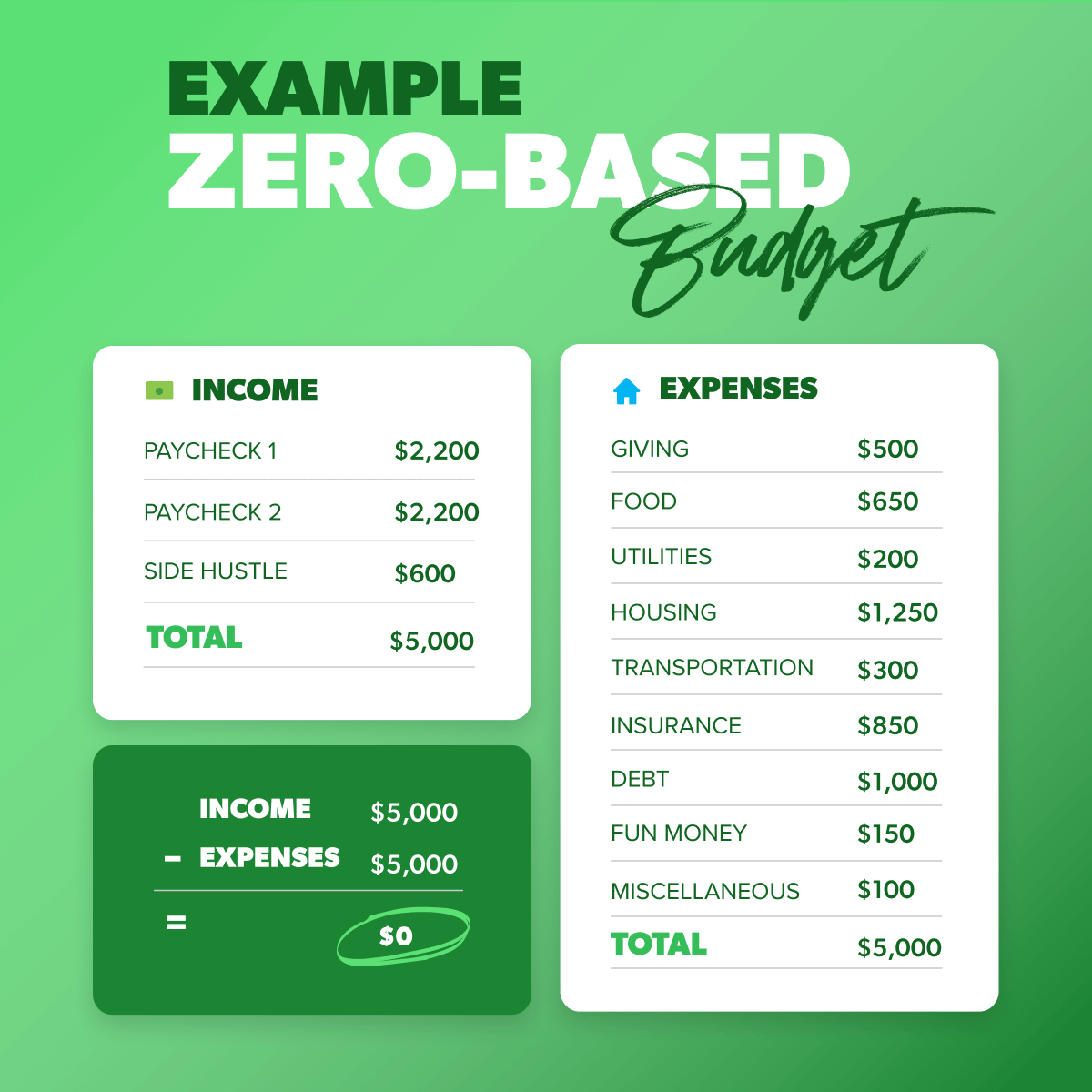[ad_1]
For those who’re out there for a budgeting technique that’s one of the best on your cash, may I recommend the zero-based finances? (I would. I will.) However what makes it one of the best? And the way do you make (and hold) a zero-based finances?
Let’s reply all that. Proper now.
What Is Zero-Primarily based Budgeting?
Zero-based budgeting is when your revenue minus your bills equals zero. Excellent title, proper?
So, in case you make $5,000 a month, all the things you give, save or spend ought to add as much as $5,000. Each greenback that is available in has a goal, a job, a objective. Nothing is left hiding or getting mindlessly spent on grande, no-whip, half-caff, white chocolate mochas with a single pump made with soy. You recognize what? Scratch that. Coconut milk. You’re doing full keto, keep in mind?
However I wish to be clear: A zero-based finances doesn’t imply you’ve got zero {dollars} in your checking account. It simply means your revenue minus all of your bills equals zero. Preserve your self just a little buffer of $100–300!
How you can Make a Zero-Primarily based Finances
Earlier than you begin making your zero-based budget, log in to your checking account or seize these financial institution statements out of the drawer you shoved them into pondering, I’ll want that in the future. (Guess what: Sooner or later is right here!) Having this in entrance of you’ll come in useful once you’re questioning how a lot you usually make or spend on stuff. You too can try these budget percentages and averages in case you’re questioning what the standard family is spending.
Okay, right here’s how you can do a zero-based finances:
1. Checklist your month-to-month revenue.
After all you are able to do this the old style method with a sheet of paper, however I like to make use of EveryDollar. (Belief me, the mathematics that’s arising is method simpler with our free budgeting app.)
What counts as revenue? Your common paychecks and something further you intend to usher in through the month, like all that money out of your facet hustle as a pizza supply driver or weekend balloon artist for teenagers’ events. Write all of it down and add it up! That’s your whole month-to-month revenue, aka what you’ve started working with this month.
P.S. If you wish to begin getting your numbers down with our budget template after which swap over to EveryDollar, that’s cool too.
2. Checklist your bills.
Okay, now you understand what’s coming in—so it’s time to plan for what’s going out. Consider all the things you spend cash on through the month. And I imply all the things. Checklist out your bills like this:
- Giving (This must be 10% of your revenue.)
- Financial savings (This will depend on your Child Step, which I’ll clarify in a second.)
- The 4 Partitions (These are the highest bills to cowl: food, utilities, shelter and transportation.)
- Different necessities (I’m speaking about insurance coverage, debt, childcare, and many others.)
- Extras (Right here’s the enjoyable half: leisure, enjoyable cash, eating places—you get the concept.)
- Month-specific bills (Plan for any holidays, celebrations or semiannual bills due this month.)
Professional tip: Don’t neglect to provide your self a miscellaneous class too so that you’ve obtained just a little further cushion in your spending. That method, something that pops up unexpectedly isn’t an issue—it’s within the finances.
Double professional tip: While you’re placing bills within the finances, begin with wants (these 4 Partitions) earlier than desires (like enjoyable cash).
3. Subtract your bills out of your revenue to equal zero.
While you subtract all these bills out of your revenue, it ought to equal zero. For those who don’t hit zero at your first go, welcome to the bulk! Yep, that’s proper. Virtually nobody will get this proper the primary time. That. Is. Nice. However let’s discuss how you can repair it!
Start budgeting with EveryDollar today!
Obtained cash left over? First, throw some confetti and do a celebration dance. (Or in case you’re like me and might’t dance to save lots of your life, a hearty fist pump will do.) Then, put that cash to work!
The place?
In your present Child Step!
What’s that?
I informed you I’d come again to this. It’s definition time: The 7 Baby Steps are the confirmed, guided path to economize, repay debt, and construct wealth (aka win with cash). They’re the seven cash objectives that can take you from the place you might be to the place you wish to be. Placing your cash right here offers you probably the most bang for these leftover bucks.
However what occurs in case you don’t have cash left over? Let’s discuss what to do in case you subtract your deliberate bills and find yourself with a adverse quantity. This implies you’re spending greater than you make, and that simply gained’t work. However don’t freak out. You can get the quantity to zero.
Get out your metaphorical hedge clippers, and trim that finances. You’ll be able to decrease your deliberate spending quantities the place you’re in a position or cut some spending out fully. (FYI, begin with the restaurant line! Then take up meal planning to save lots of on groceries and hold from being tempted to hit the drive-thru every evening.)
You too can up your revenue by beginning a side hustle, promoting stuff, or discovering another strategy to make more money. (For those who aren’t already a weekend balloon artist, it may very well be time to start out. Heck, perhaps you are taking this gig into weeknights for much more further revenue.)
That’s it for making the zero-based finances, however I’ve obtained two extra steps that’ll assist you to truly stick with it.
4. Observe your bills (all month lengthy).
So, you possibly can’t simply arrange that finances and go away it. That will get you actually nowhere together with your cash. You’ve obtained to get in there and track your transactions. Each single one. Meaning any cash that is available in or goes out will get put into the best finances line.
While you make $100 out of your facet hustle, add that cash to your revenue class. While you pay the lease, subtract that expense from housing. While you refill the fuel tank, subtract that from the fuel finances line below transportation.
That is the way you keep on prime of your spending. That is how you retain from overspending.
By the way in which, you possibly can streamline this course of with the premium version of EveryDollar. You’ll join your financial institution to your finances so transactions stream proper in. Then, you simply have to tug and drop them into place!
5. Make a brand new finances (earlier than the month begins).
Whereas it’s true your finances gained’t change a ton month after month, it’ll change some. So, create a brand new zero-based finances each single month. Keep in mind these month-specific expenses I discussed within the second step? That is the place they actually come into play.
Additionally, do that earlier than the month begins so that you’re prepared, forward of time, for what’s coming your method.
By the way in which, in order for you some extra data on how you can begin, mess around with our Budget Calculator.
Instance of a Zero-Primarily based Finances
Right here’s an excellent primary instance of a zero-based finances so you possibly can see how the mathematics works out.
Benefits of Zero-Primarily based Budgeting (Over Different Budgeting Strategies)
1. 50/30/20 Rule
The 50/30/20 budgeting rule follows these percentages: 50% of your revenue goes towards your wants, 30% goes towards desires, and 20% goes towards financial savings. After all it’s good to have some numbers that will help you begin budgeting, however these numbers go away quite a bit to be desired. And I imply quite a bit.
To start with, in case you’re utilizing our Child Steps (which you actually ought to), you aren’t at all times placing cash towards financial savings. You’re taking your objectives one (child) step at a time. That type of focus brings fast wins and lasting wealth.
Second, the 50/30/20 rule lumps debt into wants—however requires you to make minimal funds solely. You’ll be able to’t make most progress with minimal funds.
Third, these three percentages keep the identical regardless of the place you might be in life. For those who’ve obtained a ton of scholar mortgage debt—50/30/20. For those who’re debt-free and investing in retirement—50/30/20.
And at last, once you do the mathematics on common revenue minus common bills, the typical American spends far more than 50% on wants. It’s extra like 80%. This technique doesn’t even work, individuals. (My Good Cash Pleased Hour co-host and pal Rachel Cruze breaks down the mathematics on that and all the things else in regards to the 50/30/20 rule, in case you’re .)
2. 60% Answer
Within the 60% answer technique, you cowl all of your wants and needs with 60% of your finances. The opposite 40% is for saving. Then, that 40% will get divided up into three financial savings classes (10% for retirement, 10% for long-term financial savings, 10% for short-term financial savings) with 10% left for “enjoyable.”
To start with, that’s a variety of dividing. Second, I really like financial savings—however in case you’ve obtained debt, you shouldn’t be placing 40% of your cash into financial savings. You need to be destroying that debt. Hardcore. And after that, it’s best to put as a lot as you possibly can into constructing your fully funded emergency fund. And after that, it’s best to make investments 15% in retirement.
Additionally, keep in mind—the typical American is spending round 80% on wants. The 60% answer math doesn’t work. And this technique simply doesn’t account for each budgeter’s particular person scenario.
3. Reverse Budgeting
Many budgeting strategies have you ever put aside cash for spending first and financial savings second. With reverse budgeting, it’s the other. (Therefore the title.)
On this technique, you set your finances for saving and investing first. Then you definately put all the things else in there (like housing, fuel, meals, insurance coverage, debt and the nonessentials).
So, I really like the emphasis on financial savings not being an afterthought! As a result of it’s truthfully fairly simple to neglect about it.
However once more, this technique locks you into a method that may not match the cash objective you’re in the course of! For those who’re on Baby Step 2, you aren’t pondering financial savings first. You’re centered on kicking debt out of your life eternally.
4. Set It and Overlook It
Okay, you’ve obtained to start out someplace with a finances. For those who’ve by no means made one, getting all of your numbers down (revenue and bills) is your first step. However you don’t cease there. You don’t simply go away these numbers on the web page and hope you’ll live by them.
That is the “set it and neglect it” budgeting technique. And it actually doesn’t work. It helps you see the place your cash ought to go—but it surely doesn’t make you accountable for the place it truly goes. And it’s a good way to overspend. No, thanks.
5. Zero-Primarily based Budgeting
You’ll be able to in all probability see why I’m such an enormous fan of zero-based budgeting. It’s far more customizable for the place you might be in your life. You get to determine how a lot to place towards debt, financial savings, retirement, and all the things else. Each. Single. Month.
You too can adapt your zero-based finances as you undergo the Child Steps. That’s what it’s made for! Each single greenback is working for you. All the time.
Can You Make a Zero-Primarily based Finances With an Irregular Revenue?
Why, sure. Sure, you possibly can! In case you have an irregular income (that means your revenue isn’t the identical every paycheck or comes at completely different occasions within the month), you possibly can nonetheless use zero-based budgeting. It’ll simply look just a little completely different for you.
- While you’re itemizing your revenue, discover out what you’ve made the previous few months. (That is one other place your financial institution statements are useful.)
- Take the lowest quantity you made in that point and record it within the finances as this month’s deliberate revenue.
- You’ll be able to regulate the revenue later within the month in case you make extra.
While you’re itemizing your bills, observe the record from earlier. Simply know that the extras might need to attend till you understand you can afford them. Cowl crucial issues first. For those who receives a commission greater than you deliberate, perform a little fist pump—then add that more money to your Child Step or one other finances line.
You should utilize our Irregular Income Budget Planning form to get began!
So, Why Is Zero-Primarily based Budgeting Essential?
Right here’s the deal. If you wish to make any progress together with your cash, you could make a monthly budget. Folks say budgeting takes them from questioning the place their cash went to telling it the place to go. That. Is. Empowering.
And a zero-based finances? Even higher. Since you’re telling each single greenback the place to go. You’re employed exhausting on your cash—all of it. So all of it ought to work exhausting for you.
And don’t neglect EveryDollar—the free strategy to create your zero-based finances. You make the cash, and it does the mathematics. What a lovely relationship.
Hear: No matter your money goal, no matter your Child Step, wherever you might be in your private finance journey—a zero-based finances is what is going to get you (and hold you) shifting ahead.
[ad_2]
Source link




